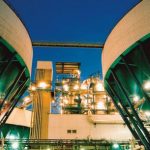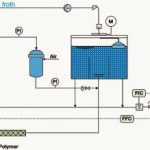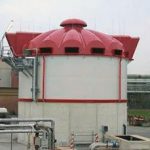Bayer Technology Services, created as part of the restructuring of the Bayer group, offers its services to customers not only within but also outside the Bayer group worldwide. Key products such as environmental technology play a particularly important role in the marketing of the company’s services to external clients.
The key products of Bayer Technology Services are those where the service provider possesses excellence across the board. This means not only that technical know-how is present, but also that the corresponding plants can be constructed, commissioned and optimised. Environmental technology is one of these key products, waste water technology being one of its main pillars. Bayer Technology Services has been decisively involved in numerous waste water projects and technical developments in the last few years. Best known amongst these are the Bayer tower biology, Loprox and high performance flotation processes.
Tower biology and Loprox processes
Bayer’s tower biology technology comprises an aerobic biological waste water purification process that is carried out in approximately 20 m high tanks. The air which is necessary for the respiration of the pollution consuming bacteria is introduced by means of special injectors. These guarantee highly effective mixing and optimal oxygen supply combined with low energy consumption.
The Loprox process permits cost-effective treatment of highly concentrated waste waters. Organic contaminants which are unsuitable for biological degradation are converted into substances easier to degrade. The employment of environmentally friendly catalysts allows the process to be carried out under relatively mild reaction conditions. This in turn has a beneficial impact on material requirements and lifetimes.
Sixth high performance flotation plant up and running
The high performance flotation method is characterised by an enclosed tower design unusual in flotation plants. The circular flotation tank is mounted on a round supporting unit which contains the engine and other system components. The top of the flotation tank is covered by a plastic cover (accessible to personnel), ensuring protection of the delicate flotation froth. The arm of a rotating froth suction device is mounted on a bridge spanning the tank. This device is operated in an isokinetic fashion and permits careful and precise removal of the froth.
The efficiency of the process is particularly enhanced by the optimised flow conditions in the flotation cell. In the region around the inlet the contact of ultra-fine gas bubbles and flocs is encouraged by the creation of a zone of turbulent flow. By means of flow-guiding structures and the special cell geometry, the flow in the clarification zone can then be successfully calmed to the point where the bubble-floc aggregates are able to rise to the surface without being subjected to mechanical shear.
A further feature involves the saturation and pressure release of the recycling stream. Here it is crucial to achieve saturation levels of the water of more than 90 % in combination with an energy efficiency and space-time yield that are as high as possible, so as to obtain bubbles with a very fine size distribution. Furthermore, the relevant components must be immune to blockage and fouling as well as to foaming.
This system guarantees high separation rates and optimal clarification quality as well as relatively low consumption levels of energy, air and flotation agents. The performance of these units under certain conditions exceeds that which is currently possible using conventional state-of-the-art systems. High up-times and low failure susceptibility are further indications of the performance of this technology.
At the Bayer site in Dormagen the sixth full-scale unit of this type to be constructed – a pressure-release flotation unit – recently commenced operation. It is employed in the separation of activated sludge from the effluent of a biological clarification plant and thus takes the place of the post-clarifier.
Further techniques available
Alongside the processes described above, Bayer Technology Services can also claim expertise in the testing and application of other established methods for the treatment of industrial effluents. As an alternative to the Loprox oxidation process using oxygen, it is possible to oxidise waste waters using hydrogen peroxide or ozone. Chemical conversion of pollutants can also be successfully achieved by means of hydrolysis or reduction processes.
Substances contained in waste waters can additionally be separated by employing adsorption, extraction, stripping or precipitation techniques. Effluents can be concentrated by evaporating down, by distillation or by applying membrane processes, and the resulting concentrates subjected to further treatment.
Concept and design
In order to comply with legal thresholds, it is often necessary to attain separation rates of more than 99.9 %. In practice this is generally only possible by employing specially customised, multi-stage plants in which different technologies are combined. Moreover, parameters such as pH, temperature and chemical metering rates typically have to be regulated and harmonised with one another. The separated residues then have to be further concentrated or alternatively dewatered and dried.
Bayer Technology Services helps its customers select the best suited treatment concept for each individual application, then optimises this concept for practical operation, undertakes the design, planning, turnkey construction and commissioning of the plant and provides the necessary operator training. Each project is carried out by a multi-disciplinary team of chemical engineers and highly qualified planners. All of the treatment techniques mentioned above can be tested on both a laboratory and a pilot-plant scale. Calculations are performed based on suitable simulation models. The interdisciplinary expertise available at Bayer Technology Services gives the customer the convenience and efficiency of receiving a complete solution from a single supplier.
cav 438
Share:









